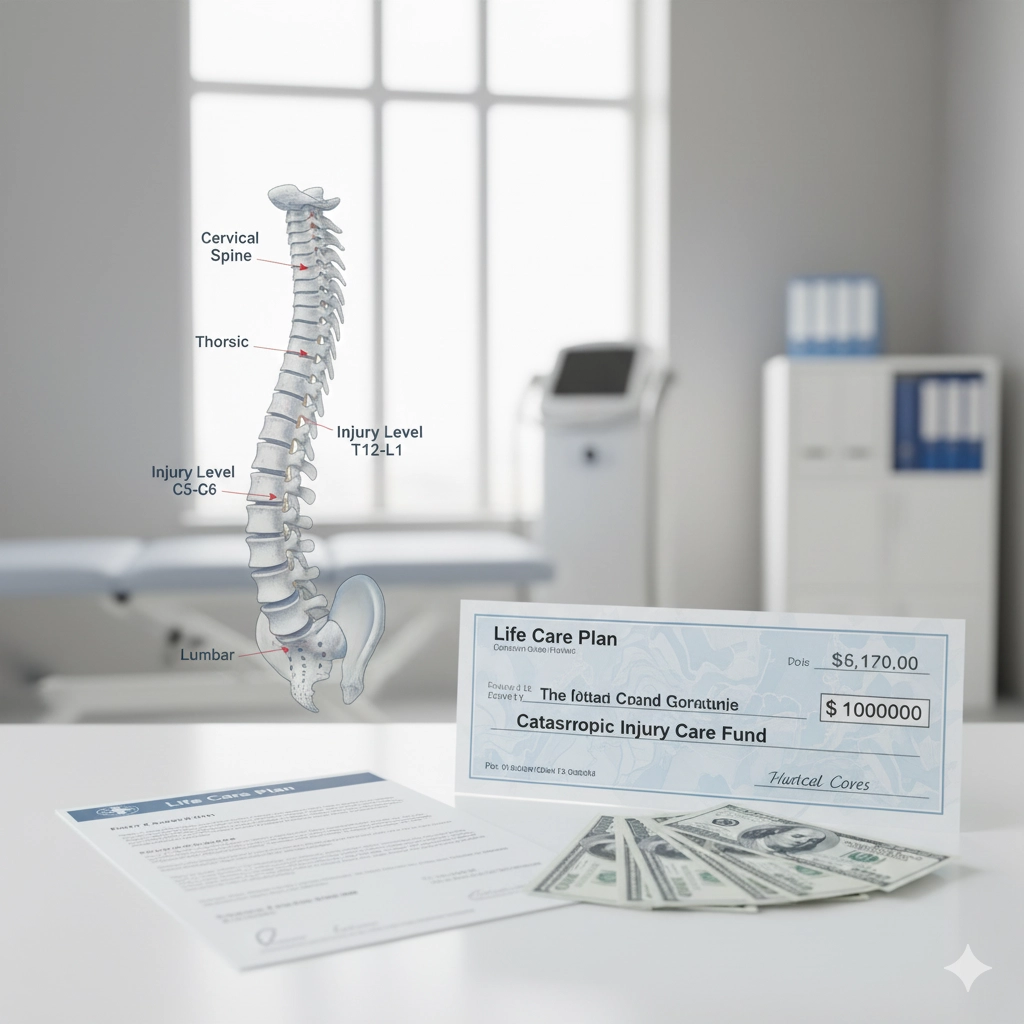A spinal cord injury from someone else’s negligence completely changed your life in an instant. You can’t walk, can’t feel parts of your body, and face a future that looks nothing like what you planned. Medical bills exceed hundreds of thousands of dollars while your lawsuit moves slowly through the courts. You worry about paying for specialized care, adaptive equipment, and basic survival while fighting insurance companies that refuse to offer fair compensation. Spinal cord injury lawsuit loans from 123 Lawsuit Loans provide the financial stability you desperately need right now. We give you cash today based on your expected settlement, with zero risk and no monthly payments.
Approximately 17,500 Americans suffer spinal cord injuries annually through car accidents, falls, violence, and medical errors. These catastrophic injuries create paralysis, loss of sensation, and permanent disability requiring millions of dollars in lifetime care. Spinal cord injury settlements typically range from $500,000 to over $20 million depending on injury level and completeness. High cervical injuries (C1-C4) average $5-20 million, while thoracic injuries average $2-6 million.
Why Spinal Cord Injury Cases Take Years to Settle
Spinal cord injury lawsuits typically take 2-5 years to resolve due to their complexity and the enormous compensation involved. Insurance companies hire teams of experts to dispute every aspect of your claim. They challenge injury severity, question treatment necessity, and dispute future care projections. They count on financial desperation to force you into accepting settlements that leave you struggling for life.
These settlement delays create crushing financial stress for families dealing with catastrophic injuries. Hospital bills exceed $500,000 during initial treatment. Home modifications cost $50,000-200,000. Specialized wheelchairs cost $15,000-50,000. Ventilator equipment for high cervical injuries costs $20,000-50,000 initially with ongoing expenses of $15,000-30,000 annually. Round-the-clock care costs $200,000+ yearly for people with complete quadriplegia.
Our spinal cord injury lawsuit loans eliminate this financial pressure. We provide cash within 24 hours of approval, allowing you to pay for necessary medical care, equipment, and home modifications while waiting for fair compensation. You only pay us back if you win or settle your case. If you lose for any reason, you owe us absolutely nothing. This non-recourse funding gives you the financial strength to reject inadequate offers and fight for every dollar you need.
How Spinal Cord Injury Lawsuit Loans Work – Zero Risk Funding
Spinal cord injury lawsuit loans are cash advances on your expected settlement, not traditional loans requiring monthly payments and credit checks. Traditional loans create debt you must repay regardless of your lawsuit outcome. Our spinal cord injury lawsuit loans only get repaid if you win or settle your case.
Here’s how our funding process works. You apply with basic information about your spinal cord injury, accident details, injury level, and attorney contact information. We evaluate your lawsuit’s strength and settlement potential by working directly with your lawyer to understand injury severity, treatment needs, future care requirements, and liability evidence.
Once approved, we send you a clear funding agreement explaining all terms including the advance amount, monthly rate or fee structure, and estimated repayment amounts based on different settlement timelines. After you sign, we deposit money directly into your bank account within 24 hours.
You use this money however you need – medical bills, equipment purchases, home modifications, care assistance, anything. There are no restrictions on how you spend spinal cord injury lawsuit loan funds. When your case settles, your attorney pays us back from your settlement proceeds. The repayment amount depends on how long your case takes and our agreed-upon rate.
But if you lose your case for any reason, you pay us nothing. Not a single penny. This non-recourse structure means all risk is on us, not you. We only get paid if you win. Your attorney handles everything during repayment, so you never write a check or make a monthly payment.
Get Cash in 24 Hours – No Credit Checks Required
We know you need money fast when dealing with catastrophic spinal cord injuries. Specialized medical equipment, home modifications, and care assistance can’t wait for lawsuits to settle years from now. That’s why we offer 24-hour approval and cash in your hands within one business day after approval. Our streamlined process gets you money quickly without bureaucratic delays.
There are no credit checks because your personal credit score doesn’t matter for spinal cord injury lawsuit loans. We’re not looking at your job history, income, or financial background. The only thing that matters is your lawsuit’s strength and expected settlement value based on injury severity, medical treatment, and liability evidence.
You also won’t face any monthly payments while waiting for your case to resolve. Traditional loans require payments every month, even when you’re dealing with paralysis and catastrophic disability. Our funding is completely different. You get the money now and only pay it back if and when you win your case.
The Financial Impact of Spinal Cord Injuries – Lifetime Costs Exceeding Millions
Spinal cord injuries create the highest medical expenses of any injury category. These costs begin immediately and continue for decades, creating financial devastation that settlement loans help address during litigation.
Emergency Response and Initial Medical Treatment Costs
Spinal cord injuries require immediate emergency medical response. Trauma care during initial hospitalization often costs $200,000-800,000. Emergency room treatment, ambulance transport with spinal immobilization, trauma team activation, and emergency surgery create enormous bills within days of injury.
Spinal stabilization surgery costs $75,000-300,000 for initial procedures preventing further cord damage. Complex cervical fusions, decompression procedures, and hardware insertion require specialized surgical teams. Extended operating room time and advanced techniques add substantial costs.
Intensive care unit stays average 2-8 weeks and cost $5,000-20,000 daily. Total bills reach $70,000-1,120,000 during critical care phases. Ventilator support for high cervical injuries, specialized monitoring, and round-the-clock nursing care add substantial costs during life-threatening periods.
Diagnostic imaging including CT scans, MRI studies, and myelograms cost $15,000-60,000 during emergency evaluation. These tests determine injury level, completeness, and spinal stability. Multiple imaging studies throughout treatment add thousands to total medical costs.
Rehabilitation and Therapy – The Long Road to Adaptation
Inpatient rehabilitation for spinal cord injuries typically lasts 3-9 months. Daily costs reach $2,000-8,000. Total bills exceed $180,000-2,160,000 during initial adjustment periods. Specialized spinal cord injury centers provide intensive therapy but charge premium rates.
Physical therapy, occupational therapy, and speech therapy for high injuries continue for years. Sessions cost $200-500 each with 3-5 sessions weekly. Annual therapy costs of $30,000-120,000 continue indefinitely as people with spinal cord injuries work to maintain function.
Respiratory therapy becomes crucial for people with high-level injuries requiring ventilator support or breathing assistance. These specialized services cost $150-400 per session. Daily or weekly sessions during recovery add $50,000-200,000 annually.
Psychological counseling addresses depression, anxiety, and adjustment disorders common after spinal cord injuries. Sessions cost $100-300 and may continue for years. Family counseling helps loved ones cope with trauma from seeing catastrophic injuries.
Specialized Medical Equipment and Technology Needs
Power wheelchairs for spinal cord injuries cost $15,000-80,000 depending on features and technology. These chairs require replacement every 5-7 years. Frequent repairs cost thousands annually throughout lifetime use.
Manual wheelchairs for people with incomplete injuries or upper extremity function cost $2,000-15,000. Multiple chairs may be needed for different environments and activities.
Hospital beds, patient lifts, and positioning equipment for home care cost $20,000-60,000 initially. These items require replacement every 7-10 years. They become essential for safe care at home and preventing pressure sores.
Communication devices, computer interfaces, and environmental controls help people with high-level injuries maintain independence. These assistive technologies cost $10,000-40,000 initially. Software updates and replacement every 5-8 years add ongoing expenses.
Ventilators and respiratory equipment for high cervical injuries cost $30,000-80,000 initially. Ongoing maintenance, supplies, and backup equipment cost $20,000-50,000 annually throughout lifetime.
Vehicle modifications including wheelchair lifts, hand controls, and specialized seating cost $30,000-100,000 per vehicle. These modifications allow transportation independence but require specialized maintenance and periodic updates.
Home Modifications and Accessibility Improvements
Home accessibility modifications cost $75,000-300,000 depending on existing home structure and disability accommodation needs. Ramps, widened doorways, accessible bathrooms, and elevator installation create substantial upfront expenses. Many people must move to single-story homes or build fully accessible new homes costing $300,000-600,000.
Bathroom modifications including roll-in showers, accessible toilets, and specialized fixtures cost $25,000-70,000 per bathroom. These modifications become essential for basic hygiene and personal care.
Kitchen modifications including lowered counters, accessible appliances, and specialized storage cost $30,000-80,000. These changes allow food preparation participation and improve quality of life.
Lifetime Care Costs According to Spinal Cord Injury Statistics
The National Spinal Cord Injury Statistical Center provides detailed lifetime cost data varying dramatically based on injury level and age at injury.
High Complete Quadriplegia (C1-C4 Injury Level)
- First Year Costs: $1.6 million
- Annual Subsequent Costs: $185,000
- Age 25 Injury: $4.7 million lifetime cost
- Age 50 Injury: $2.6 million lifetime cost
Low Complete Quadriplegia (C5-C8 Injury Level)
- First Year Costs: $770,000
- Annual Subsequent Costs: $114,000
- Age 25 Injury: $3.5 million lifetime cost
- Age 50 Injury: $2.1 million lifetime cost
Complete Paraplegia (T1-S5 Injury Level)
- First Year Costs: $519,000
- Annual Subsequent Costs: $69,000
- Age 25 Injury: $2.3 million lifetime cost
- Age 50 Injury: $1.5 million lifetime cost
Incomplete Motor Functional Injuries (Any Level)
- First Year Costs: $400,000
- Annual Subsequent Costs: $45,000
- Age 25 Injury: $1.6 million lifetime cost
- Age 50 Injury: $1.1 million lifetime cost
These statistics don’t include wage losses, fringe benefits, and productivity losses averaging $72,000 annually. Total economic impact often exceeds medical costs by substantial amounts when lost earning capacity is calculated over working lifetimes.
Employment and Income Loss – Career Devastation
Less than 12% of spinal cord injury victims are employed one year after injury. By 20 years post-injury, only 35% achieve any level of employment. Most work at reduced capacity and income levels far below pre-injury earnings.
Professional careers often end completely when spinal cord injuries prevent essential job functions. All physically demanding jobs become impossible with complete paralysis. Even incomplete injuries create limitations preventing many career paths.
Small business owners frequently lose businesses entirely. Spinal cord injuries prevent maintaining operations during extended recovery periods. Business asset losses often exceed personal medical expenses.
Career advancement opportunities are permanently lost. Spinal cord injuries prevent participation in training programs, promotions, and career development activities. These lost opportunities create long-term economic impacts beyond immediate wage losses.
Family Impact and Secondary Financial Losses
Family members often must leave jobs to provide care. They attend medical appointments and support spinal cord injury victims through recovery and legal proceedings. Spousal income losses frequently double the financial impact.
Childcare expenses increase dramatically when injured parents cannot care for children during extended recovery periods. Professional childcare services may be needed for months during rehabilitation.
Family counseling helps families cope with trauma from seeing loved ones suffer catastrophic injuries. These services cost $100-300 per session. They continue for years as families adjust to life-changing disabilities.
Transportation costs increase substantially when spinal cord injury victims cannot drive. They require assistance getting to medical appointments, therapy sessions, and legal meetings. Specialized transportation costs reach hundreds monthly.
Types of Spinal Cord Injuries We Fund – Classification and Impact
Spinal cord injury lawsuit loans are available for all spinal cord injury types resulting from negligent conduct. Different injury categories have different settlement values and funding potentials based on injury level, completeness, and functional limitations.
Cervical Spinal Cord Injuries – Quadriplegia and Tetraplegia
Cervical injuries affect the neck region and create quadriplegia or tetraplegia, impacting all four limbs and potentially affecting respiratory function, bowel/bladder control, and temperature regulation.
C1-C4 Complete Injuries (High Quadriplegia) create the most severe disability. These injuries require ventilator support for breathing. Victims need total care assistance for all daily activities. Settlement values range from $8 million to $20 million+ for young victims with clear liability.
C5-C8 Complete Injuries (Low Quadriplegia) allow some arm and hand function. Victims may operate power wheelchairs independently. They still need substantial care assistance. Settlement values range from $5 million to $15 million depending on age and circumstances.
C1-C4 Incomplete Injuries create varying degrees of paralysis and sensation below the neck. Recovery potential exists but remains uncertain for months. Settlement values range from $3 million to $12 million based on functional outcomes.
C5-C8 Incomplete Injuries offer better prognosis with potential for significant recovery. Many people achieve independence in basic activities. Settlement values range from $1 million to $8 million.
Thoracic Spinal Cord Injuries – Paraplegia
Thoracic injuries affect the mid-back region and create paraplegia, impacting the legs and lower trunk while preserving upper body function.
T1-T6 Complete Injuries affect upper thoracic segments. These injuries impair trunk stability and breathing capacity. Settlement values range from $3 million to $8 million.
T7-T12 Complete Injuries affect lower thoracic segments. These injuries preserve better trunk control and respiratory function. Settlement values range from $2 million to $6 million.
T1-T12 Incomplete Injuries create varying degrees of lower extremity weakness and sensation loss. Walking potential depends on injury severity. Settlement values range from $800,000 to $4 million.
Lumbar and Sacral Spinal Cord Injuries
Lumbar and sacral injuries affect the lower back region. These injuries create varying degrees of leg weakness, bowel/bladder dysfunction, and sexual function changes.
L1-L5 Complete Injuries create lower extremity paralysis with preserved trunk function. Most people use wheelchairs for mobility. Settlement values range from $1.5 million to $5 million.
S1-S5 Complete Injuries affect sacral segments controlling bowel, bladder, and sexual function. Lower extremity weakness varies. Settlement values range from $1 million to $3 million.
Incomplete Lumbosacral Injuries offer good recovery potential. Many people walk with assistive devices or independently. Settlement values range from $500,000 to $2 million.
Complete vs Incomplete Spinal Cord Injuries
Injury completeness dramatically affects settlement values and funding amounts. Complete injuries have no motor or sensory function below the injury level. Incomplete injuries preserve some function.
Complete Injuries (ASIA A) create total loss of motor and sensory function below the injury level. These injuries typically don’t improve significantly. Settlement values reflect lifetime total care needs.
Incomplete Injuries (ASIA B-D) preserve varying degrees of sensation and movement below the injury level. Recovery potential exists but varies dramatically. Settlement values depend on functional outcomes achieved during rehabilitation.
Central Cord Syndrome
Central cord syndrome creates disproportionate upper extremity weakness compared to lower extremities. This incomplete injury pattern often occurs in older adults with pre-existing spinal stenosis. Recovery potential varies widely. Settlement values range from $500,000 to $3 million.
Brown-Sequard Syndrome
Brown-Sequard syndrome creates weakness and loss of proprioception on one side with pain and temperature loss on the opposite side. This incomplete injury pattern has good recovery potential. Settlement values range from $400,000 to $2 million.
Anterior Cord Syndrome
Anterior cord syndrome affects the front portion of the spinal cord. This creates paralysis and loss of pain and temperature sensation with preserved light touch and proprioception. Settlement values range from $600,000 to $3 million.
Cauda Equina and Conus Medullaris Injuries
Cauda equina injuries affect nerve roots rather than spinal cord. These create lower extremity weakness, bowel/bladder dysfunction, and sensory loss. Settlement values range from $400,000 to $2 million depending on recovery outcomes.
Spinal Cord Injury Settlement Values and Compensation Patterns
Spinal cord injury settlements represent the highest values in personal injury law. These catastrophic injuries require comprehensive compensation for lifetime medical care, equipment needs, home modifications, and lost earning capacity.
National Settlement Statistics and Injury Level Factors
Spinal cord injury settlements typically range from $500,000 to over $20 million depending on injury level, completeness, age at injury, and liability strength. The highest settlements occur in young victims with complete high cervical injuries from clear negligence.
Settlement amounts must account for medical costs, lost earning capacity, pain and suffering, and other damages over lifetime expectancies often exceeding 40-60 years post-injury for young victims.
Notable Spinal Cord Injury Settlement Examples
$32.8 Million – Rear-End Collision (Los Angeles) A man received $32.8 million after being rear-ended by a state employee. He suffered traumatic brain injury and spinal cord injury. The award included $700,000 for past medical expenses and $9 million for future medical expenses.
$56 Million – Bicycle Accident (Texas) A cyclist received $56 million after a truck accident left him with extensive injuries and permanent brain damage. The defendant fled the scene creating punitive damages.
$4.2 Million – Scaffolding Collapse A construction worker received $4.2 million for T6 complete injury from scaffolding collapse. Clear OSHA violations and young victim age contributed to the settlement.
$7.4 Million – Motorcycle Accident (Arizona) A motorcyclist received $7.4 million after a semi-truck made a negligent left turn causing a collision resulting in spinal cord injury.
$3 Million – Passenger Injury (Colorado) A passenger received $3 million after suffering spinal cord injury when the driver lost control while fleeing police. Part of the award established a special needs trust.
Factors Affecting Spinal Cord Injury Settlement Values
Injury Level and Completeness dramatically impact settlement amounts. High cervical complete injuries produce the highest compensation due to total care needs and ventilator dependence.
Age at Injury significantly affects settlements. Younger victims receive higher compensation due to longer life expectancies requiring decades of care and greater lost earning capacity.
Pre-Injury Earning Capacity influences economic damages. High-earning professionals receive greater compensation for lost income and career advancement potential.
Evidence of Liability strengthens settlement positions. Clear negligence, safety violations, and reckless conduct support maximum compensation.
Defendant Resources influence settlement potential. Well-insured corporations and government entities can pay larger settlements than individuals with minimal coverage.
Life Care Planning establishes future medical needs and costs. Comprehensive planning by experts supports higher settlement amounts.
Functional Recovery affects incomplete injury settlements. Better outcomes reduce care costs and settlement expectations while worse outcomes increase compensation needs.
Medical Complications including pressure sores, infections, and secondary conditions increase settlement values when they create additional care needs and suffering.
Why Insurance Companies Fight Spinal Cord Injury Claims
Insurance companies employ sophisticated strategies to minimize spinal cord injury settlements despite catastrophic injuries requiring millions in lifetime care.
Corporate Defense Teams and Expert Networks
Major insurance companies maintain specialized catastrophic injury units handling spinal cord injury claims with experienced attorneys and adjusters trained to minimize settlements.
These companies employ national law firms specializing in catastrophic injury defense. Teams of experts challenge every aspect of care needs and future cost projections.
Defense medical experts regularly testify that injuries are less severe than claimed, recovery potential is better than projected, or treatment options can minimize care needs.
Life care planning experts hired by insurance companies project lower care costs than plaintiff experts, creating disputes about future medical expenses.
Medical Defense Tactics and Causation Challenges
Insurance companies argue that pre-existing spinal conditions contributed to injuries. Medical records showing any prior back or neck problems become weapons against fair compensation.
Treatment gap arguments claim delayed care proves injuries weren’t serious. Any delay between accidents and treatment creates opportunities to dispute causation.
Alternative causation theories argue that other factors caused paralysis. Defense experts may claim injuries resulted from subsequent falls, medical complications, or pre-existing conditions.
Recovery potential arguments claim that advancing medical technology will reduce future care needs. Experimental treatments and therapies are cited to minimize settlement projections.
Settlement Negotiation and Pressure Tactics
Initial offers of $100,000-500,000 for injuries worth millions attempt to exploit financial desperation. Insurance adjusters hope immediate needs will force acceptance of inadequate compensation.
Delay tactics include requesting excessive documentation, scheduling multiple medical examinations, and prolonging discovery to exhaust resources.
Structured settlement proposals attempt to reduce present value by spreading payments over many years rather than providing lump sum compensation.
Comparative negligence arguments attempt to reduce settlements by claiming victims contributed to accidents through their own negligence.
The Application Process for Spinal Cord Injury Lawsuit Loans
Getting pre-settlement funding for spinal cord injury cases involves comprehensive evaluation of injury severity, medical documentation, settlement potential, and immediate financial needs.
Step 1: Complete Spinal Cord Injury Documentation
Our spinal cord injury lawsuit loans application requires detailed information about injury circumstances, injury level, completeness classification, medical treatment, and legal representation.
Provide complete details about the accident including date, location, responsible parties, and available evidence establishing liability.
Medical records including emergency room reports, imaging studies, surgical reports, rehabilitation assessments, and ASIA impairment classifications help establish injury severity.
Current functional status, care needs, and equipment requirements help assess damages and settlement potential.
Step 2: Legal Case Review and Liability Assessment
We coordinate with your catastrophic injury attorney to review case documents, medical evidence, and settlement discussions to assess claim strength.
Our underwriting team includes professionals experienced in spinal cord injury litigation who understand medical terminology, care planning, and settlement patterns.
We evaluate liability evidence including accident reports, expert witness testimony, and defendant resources to assess settlement potential.
Discovery status and expert witness development help us understand case development timeline.
Step 3: Medical Analysis and Injury Assessment
We analyze medical records, ASIA classifications, and functional assessments to understand injury severity and prognosis.
Our medical reviewers consider injury level, completeness, and recovery progress to assess care needs and damages.
We evaluate life care planning projections to understand lifetime costs settlements must address.
Step 4: Settlement Analysis and Economic Evaluation
We analyze economic damages including medical expenses, lost earning capacity, and future care costs.
Non-economic damages for pain and suffering, loss of enjoyment, and disability impacts represent substantial settlement components.
We review comparable spinal cord injury cases to establish reasonable settlement expectations.
Step 5: Defendant Resources and Insurance Evaluation
We assess defendant insurance coverage and payment capacity to ensure adequate funds exist for catastrophic injury settlements.
Corporate defendants and government entities typically maintain substantial liability coverage designed to handle multi-million dollar claims.
Step 6: Risk Assessment and Funding Decision
Our underwriters consider all case factors to determine funding eligibility and amounts.
Injury severity and completeness significantly influence settlement potential and funding amounts.
Clear liability evidence supports higher funding based on settlement expectations.
Benefits of 123 Lawsuit Loans for Spinal Cord Injury Cases
Our expertise in catastrophic injury litigation and commitment to supporting spinal cord injury victims makes us the preferred funding source nationwide.
Specialized Catastrophic Injury Experience Since 2008
We’ve provided funding for thousands of catastrophic injury cases including spinal cord injuries from car accidents, falls, and medical malpractice.
Our underwriting team understands spinal cord injuries and settlement patterns better than general funding companies.
This specialized knowledge allows us to approve cases others reject and provide appropriate funding amounts.
We maintain relationships with attorneys who trust us to treat catastrophic injury clients fairly.
Fast Approval Process for Medical Emergencies
Most applicants receive funding decisions within 24-48 hours when documentation is provided.
Emergency situations involving immediate medical needs or equipment purchases may qualify for same-day approval.
We understand spinal cord injury victims face immediate financial crises requiring urgent assistance.
Our streamlined process eliminates bureaucratic delays.
Risk-Free Non-Recourse Funding
Spinal cord injury lawsuit loans are completely non-recourse – you only repay if you win.
We provide transparent agreements with clear terms and no hidden fees.
Your attorney reviews all documents to ensure complete understanding.
Our funding doesn’t affect case strategy or settlement decisions.
Flexible Funding Amounts
We provide funding from $10,000 to $1,000,000+ depending on case strength and settlement potential.
Initial amounts can be increased as cases develop stronger evidence and higher projections.
We work with attorneys to determine appropriate funding that meets needs while maintaining reasonable repayment expectations.
Start Your Spinal Cord Injury Lawsuit Loans Application Today
Stop letting insurance companies use financial pressure to force inadequate settlements that don’t address lifetime care needs.
Risk-Free Application Process
Applying costs nothing and creates no obligation.
Our confidential process won’t affect your lawsuit.
You maintain complete control over legal representation.
Work With Your Current Attorney
You don’t need to change lawyers.
Many catastrophic injury attorneys facilitate rapid approvals.
Your lawyer reviews all agreements.
Fast Money for Medical and Care Needs
We understand spinal cord injury victims face immediate financial crises.
Most applicants receive approval within 24-48 hours.
Approved funding is deposited within 24 hours.
Focus on Recovery Instead of Bills
Spinal cord injury lawsuit loans allow you to focus on rehabilitation.
Cover essential expenses while your attorney builds your case.
Remove pressure that could force inadequate settlements.
Apply today and you could have cash in your account tomorrow.
Important Legal Disclaimers:
This is not a traditional loan. Spinal cord injury lawsuit loans are non-recourse funding – you only pay back if you win or settle. Rates and terms vary based on case specifics. Your attorney must be involved and will receive all agreements for review.
This funding does not affect your attorney’s fees, case strategy, or settlement negotiations. 123 Lawsuit Loans has been serving catastrophic injury plaintiffs since 2008 with an A+ BBB rating and 98% customer satisfaction.
Individual results vary based on injury severity, medical documentation, legal representation, and defendant resources. Past settlement amounts do not guarantee similar outcomes.





